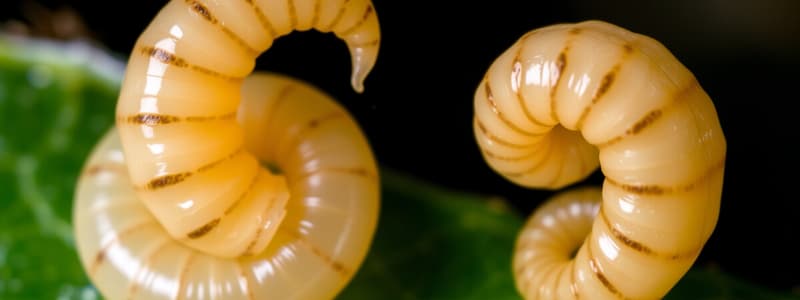Podcast
Questions and Answers
What is the classification of Trichinella spiralis?
What is the classification of Trichinella spiralis?
- Animalia
- Nematode
- Roundworm
- All of the above (correct)
What are the intermediate hosts (IH) for Trichinella spiralis?
What are the intermediate hosts (IH) for Trichinella spiralis?
Pigs, bears, warthogs, rodents
What is the definitive host (DH) for Trichinella spiralis?
What is the definitive host (DH) for Trichinella spiralis?
Humans
Trichinellosis is acquired by eating meat containing ______.
Trichinellosis is acquired by eating meat containing ______.
What happens to larvae once ingested and exposed to gastric acid in the small intestine?
What happens to larvae once ingested and exposed to gastric acid in the small intestine?
What is a common treatment for Trichinellosis?
What is a common treatment for Trichinellosis?
Trichinellosis larvae exclusively migrate to the intestinal tract.
Trichinellosis larvae exclusively migrate to the intestinal tract.
What is the primary mode of transmission for Trichinella spiralis?
What is the primary mode of transmission for Trichinella spiralis?
What should be done to prevent transmission of Trichinella spiralis?
What should be done to prevent transmission of Trichinella spiralis?
What type of epidemiology is associated with high pork consumption and rural villages?
What type of epidemiology is associated with high pork consumption and rural villages?
What immunologic assay is often used for diagnosis?
What immunologic assay is often used for diagnosis?
Flashcards are hidden until you start studying
Study Notes
Classification
- Belongs to the kingdom Animalia and phylum Nematoda.
- Commonly known as a roundworm.
Morphology/Structure
- Structure details not provided, additional research needed for specifics.
Key Players
- Intermediate Hosts (IH): Includes pigs, bears, warthogs, and rodents.
- Definitive Host (DH): Humans, who acquire the infection through consumption of infected meat.
Life Cycle
- Trichinellosis is contracted by ingesting meat that contains encysted larvae.
- In the small intestine, gastric acid and pepsin trigger the release of larvae.
- Larvae invade the small bowel mucosa and develop into adult worms.
- Adult females liberate new larvae, which then migrate to striated muscle tissues to encyst.
- Two cycles:
- Domestic cycle involves meat scraps or cannibalism among pork and rodents.
- Sylvatic cycle involves predation or scavenging by bears, rodents, and warthogs.
Disease
- Trichinellosis characterized by adult worms in the intestine and migration of larvae to unusual sites, including the brain.
- This process can lead to central nervous system (CNS) damage.
Diagnosis
- Diagnosis relies heavily on serological methods, particularly immunological assays like ELISA.
- Patient history is crucial for accurate diagnosis.
Treatment
- Primary treatment options include Albendazole and Mebendazole, antiparasitic medications.
Transmission
- The primary method of transmission is oral, typically through consumption of undercooked or infected meat.
Prevention + Control
- Thorough cooking of meat is essential to prevent infection.
Epidemiology
- Infection is common in regions with high pork consumption.
- Observed in rural areas where consuming bear meat is part of the local diet.
Studying That Suits You
Use AI to generate personalized quizzes and flashcards to suit your learning preferences.




